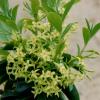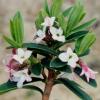 |
DAPHNE albowiana An extremely well behaved small evergreen shrub growing to less than a metre tall by a little wider. With large glossy green leaves it is very similar to D. pontica although we find it actually does better. Unusual yellow spidery flowers in April (just before D. pontica) followed by red berries. Best in a shady site. |
|
|
|
||
 |
DAPHNE
altaica A semi-evergreen shrub to 2m high of upright habit. The fragrant white flowers occur in clusters in May-June followed by red fruits. Attractive long thin greyish green leaves. Our stock came originally from the Linz Botanic Garden, Austria. It thrives in sun or light shade and is comparatively easy to please. |
|
|
|
||
| DAPHNE
blagayana 'Brenda Anderson' D. blagayana itself is highly sought after and notoriously difficult to grow. It is a rangy evergreen that needs alpine conditions in order to thrive. This selection is much more compact and oddly seems more amenable to cultivation in more normal garden conditions. They have sumptuous clusters of large milky white flowers in early spring, which appear almost too large for the compact habit. As with all daphnes, it's not happy if its foliage has to sit on wet ground. Of course this is exacerbated in the little ones by their smaller stature, but they definitely do better when planted in a good thick layer of gravel. Similarly, it's worth removing any fallen leaves that blow against them to maintain good air movement around them through the winter. |
||
|
|
||
| Daphne 'Cobhay
Pink Delight' There are few greater thrills in the garden than making your own hybrids and then experiencing the excitement of their first flowering. We believe that this unique selection is a hybrid between D. tangutica and D. wolongensis 'Guardsman'. It has the stature and comparative tolerance of D. tangutica (its seed parent) coupled with the flower structure of 'Guardsman', where the flowers are held all the way up the stem in the leaf axils. These are produced in profusion in early spring, typically March-April and are a delightful pink in colour. |
||
|
|
||
| DAPHNE 'Fragrant Cloud' CD&R 626 A wild derivative of D. acutiloba, introduced from China by Martyn Rix et al, the beautiful white flowers in March (or even earlier in a mild season or location) remind me more of D. blagayana, since they are much larger than most Daphnes. The plant however, is quite upright growing and the evergreen leaves are much larger. The scent is intoxicating. Proving to be well behaved for us, though happier in a shady site, I believe that this showy plant has a fantastic future. |
||
|
|
||
|
||
|
|
||
| DAPHNE odora Although variegation adds an extra dimension to a plant, giving colour and interest for much more of the year, but it is not to everyone's taste. The species itself is not often offered, but is a splendid plant in its own right. It is fundamentally the same in all aspects except for leaf colour as the better known 'Aureamarginata'. The vibrant flowers are highlighted dramatically against the glossy green leaves. |
||
|
|
||
 |
Daphne odora
'Double Cream' This was our own selection some years ago now. The vareigation is quite different to the more common 'Aureamarginata'. The much broader margin is a rich creamy colour (as opposed to golden yellow) whilst the green central portions of the leaf are a more bluey tone. It's a lovely plant, though probably best in a position that is at least partially shaded. Like all these daphnes of woodland origin, it is tolerant of even heavy shade. |
|
|
|
||
| DAPHNE odora
'Aureamarginata' Dark pink buds open to pale pink flowers in March which are wonderfully fragrant. The glossy dark green leaves are narrowly margined yellow. This must be one of the most sought after of all flowering shrubs. |
||
|
|
||
 |
DAPHNE
pontica hybrid This Daphne originally came to us as D. pontica. However, when it flowered, it became apparent that the flowers were not quite spidery enough to be true pontica. They are more like the "typical" Daphne flower in shape and a delightful greeny yellow in colour. They are produced in April-May and are also very sweetly scented, particularly in the evening. Sometimes referred to as the "Evening Daphne" it is moth pollinated, so will give best scent in a west facing site - ie in evening sun. The leaves are pontica like in shape but a particularly healthy deep green in colour. Blue black fruits. It must be a hybrid from D. pontica, probably with D. laureola. However, it remains an exceptionally fine plant being unusually tolerant of heavy shade and heavy clay! |
|
|
|
||
 |
DAPHNE
retusa Surprisingly unavailable, this rewarding dwarf evergreen is very slow growing and compact. The flowers are dark purple in bud, opening white tinged purple on the outside. They occur in clusters in May-June. Sun or light shade. Very similar to D. tangutica, but smaller. Expect 60cm in all directions, but it may take 20 years! Due to the slower growing nature of this plant, they are small when you receive them. Consider whether this is the right plant for you, or whether the more vigorous and better behaved D. tangutica would be more appropriate. If in doubt, please discuss with me. |
|
|
|
||
 |
DAPHNE
tangutica One of the best Daphne for the beginner! Indeed this for me is a plant that should be in every garden. It is relatively tolerant of most sites, though it prefers light shade, and freely produces masses of fragrant flowers, rich purple in bud before opening to white flowers, for an incredibly long time through the year. Typically they start flowering in April, peaking in May and then continuing as each flush of new growth ripens to produce flowers right through the summer until the first frosts in November. Red berries. |
|
|
|
||
| DAPHNE
wolongensis 'Guardsman' This species from the Sichuan province in China has only recently been described and named and this selection is a fabulous plant. It is very distinctly upright (hence the name) with small glossy, dark evergreen leaves. The flowers are smaller than some, but a wonderful rich pink, clothing the stems in early spring. It's a fabulous plant. |
||
|
|
||